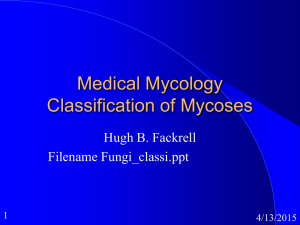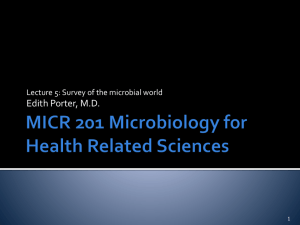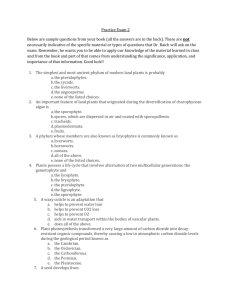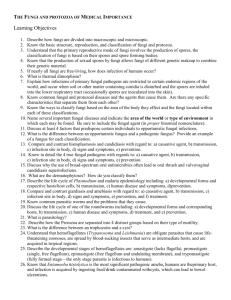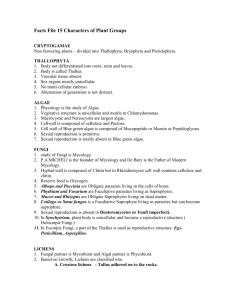Foundations in Microbiology
advertisement
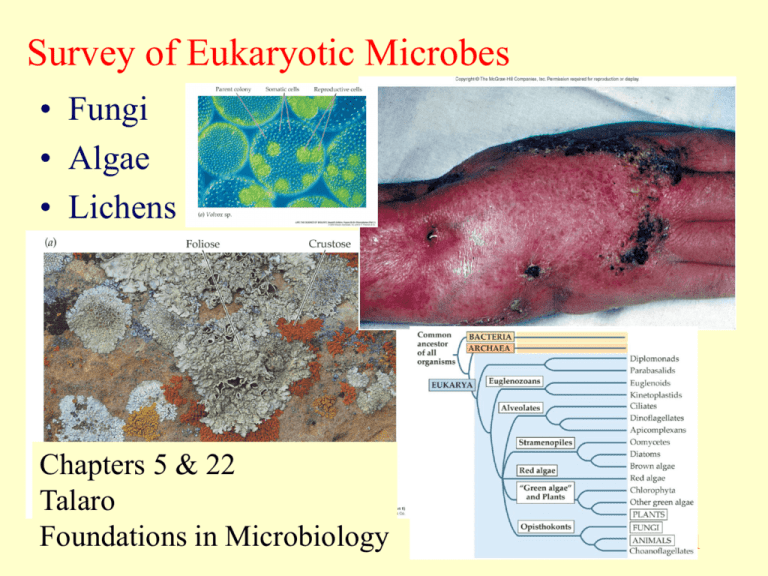
Survey of Eukaryotic Microbes • Fungi • Algae • Lichens Chapters 5 & 22 Talaro Foundations in Microbiology 1 Kingdom Fungi • • • • • • • 100,000 species divided into 2 groups – macroscopic fungi – microscopic fungi Heterotrophic none are autotrophic on their own Majority are harmless saprobes living off dead and decaying plants & animals Some are parasites, but none are obligate – Mycoses Optimal growth temperature generally mesophilic 20o - 40oC but many can grow at 4oC Extremely widespread distribution in many habitats Reproduce through spores formed on special reproductive hyphae – Asexual reproduction • Spores are formed through budding or conidia formation – Sexual reproduction • Spores are formed following fusion of male & female strains & formation of sexual structure • Sexual spores are one basis for classification • Mycology – the study of fungi 2 Septum crosswall Aseptate or coenocytic Conidium asexual spore hypha Mycelium A mass of hyphae Body of Mold 3 Asexual spores on aerial mycelia 4 Four Main Divisions • • • • Zygomycetes Ascomycetes Basidiomycetes Deuteromycetes • • •Plasmogamy - haploid nucleus of donor cell (+) penetrates cytoplasm of recipient cell (__) • Karyogamy - (+) and (__) nuclei fuse to form a diploid zygote nucleus • Meiosis - diploid nuclei gives rise to haploid nuclei No sexual spores Called by many the Fungi Imperfecti 5 Zygomycetes 6 Ascomycetes 7 Unicellular Fungi - Yeast • Two general classes - budding and fission yeast • Cell division distinguishes two classes • Budding yeast do not divide evenly • Fission yeast divide evenly Saccharomyces cerevisiae Ascomycetes with an infrequent sexual stage Schizosaccharomyces pombe 8 Basidomycetes 9 Fungi as Infectious Agents • Molds & yeasts are widely distributed in air, dust, fomites & normal flora • Humans are relatively resistant • Fungi are relatively nonpathogenic except to immunosupressed patients • Only 300 have been linked to disease in animals, of the 100,000 fungal species • Human mycoses are caused by true pathogens and opportunistic pathogens 10 Dimorphic Fungi 11 Fungal Infection • Systemic Mycoses • Deep infection, usually multiple organs affected, not transferable from organism to organism • Subcutaneous Mycoses • Infection beneath surface of skin, requires implantation of hyphae or spores via puncture wound • Cutaneous Mycoses • Caused by dermatophytes (infect epidermis, hair or nails), secrete keritinase, human to human transmission • Superficial Mycoses • Localized along hair shafts and superficial (surface) epithelial cells 12 Antifungal Compounds • Antifungals are placed into 3 categories based on their mode of action – Azoles • Inhibit the synthesis of ergosterol, the main fungal sterol in the plasma membrane • e.g., Miconazole – Polyenes • Interact with fungal membrane sterols and creates pores in the plasma membrane • e.g., Amphotericin B – 5-fluorocytosine • Cytosine analog • Inhibits nucleic acid synthesis • Fungal infections of the blood, lungs, heart & CNS and urinary tract 13 Systemic Mycoses caused by True Pathogens • • • • Histoplasma capsulatum Coccidioides immitis Blastomyces dermatitidis Paracoccidioidomycosis brasiliensis 14 Histoplasma capsulatum • Histoplasmosis • Typically dimorphic • Distributed worldwide, most prevalent in eastern & central regions of US • Grows in moist soil high in nitrogen content • Inhaled conidia produce primary pulmonary infection that may progress to systemic involvement of a variety of organs & chronic lung disease • Amphotericin B – Polyene • Ketoconazole – Azole 15 Histoplasma capsulatum 36 ºC 25 ºC Hyphal growth Yeast like colony Histoplasmosis!! 16 Subcutaneous Mycoses • • • • Mycetoma or Eumycetoma Madurella mycetomatis Agricultural workers Ketoconale – Azole • Itraconazole – Azole • Amputation 17 Cutaneous Mycoses • Infections strictly confined to keratinized epidermis (skin, hair, nails) are called dermatophytoses - ringworm & tinea • 39 species in the genera Trichophyton, Microsporum, Epidermophyton • Communicable among humans, animals, & soil • Infection facilitated by moist, chafed skin 18 • Ringworm of scalp (tinea capitis) affects scalp & hairbearing regions of head; hair may be lost • Ringworm of body (tinea corporis) occurs as inflamed, red ring lesions anywhere on smooth skin • Ringworm of groin (tinea cruris) “jock itch” affects groin & scrotal regions • Ringworm or foot & hand (tinea pedis & tinea manuum) is spread by exposure to public surfaces; occurs between digits & on soles • Ringworm of nails (tinea unguium) is a persistent colonization of the nails of the hands & feet that distorts the nail bed 19 Ringworm Treatment • Ointments containing – Tolnaftate • Azole – Miconazole • Azole – Lamisil • Azole – Griseofulvin • Inhibits fungal microtubules 20 Tinia Capitis Tinea Corporis 21 Trichophyton Ringworm of the extremities Tinia unguium 22 Superficial Mycoses • Tinea versicolor causes mild scaling, mottling of skin • White piedra is whitish or colored masses on the long hairs of the body • Black piedra causes dark, hard concretions on scalp hairs 23 Opportunistic Mycoses Opportunistic fungal pathogen Host’s defense must be impaired. Fungus has a weak or nonexistent virulence in a host with a normal functioning immune system. Candida albicans • Normal flora of oral cavity, genitalia, large intestine or skin of humans • Account for 80% of nosocomial fungal infections • Account for 30% of deaths from nosocomial infections • Thrush – Occurs as a thick, white, adherent growth on the mucous membranes of mouth & throat • Vulvovaginal yeast infection – Painful inflammatory condition of the female genital region that causes ulceration & whitish discharge • Cutaneous candidiasis – Occurs in chronically moist areas of skin and burn patients 25 Candida albicans Candida Cryptococcus 26 Cryptococcus neoformans • A widespread encapsulated yeast that inhabits soils around pigeon roosts • causes Cryptococcosis • Common infection of AIDS, cancer or diabetes patients • Infection of lungs leads to cough, fever, & lung nodules • Dissemination to meninges & brain can cause severe neurological disturbance & death 27 Cryptococcus neoformans 28 Pneumocystis carinii • A small, unicellular fungus that causes pneumonia (PCP) – The most prominent opportunistic infection in AIDS patients • This pneumonia forms secretions in the lungs that block breathing & can be rapidly fatal if not controlled with medication • Pentamidine – Mode of action is unclear – Investigations indicate that the drug inhibits the synthesis of DNA, RNA, phospholipids and proteins • Cotrimoxazole – Folate inhibitor – Azole 29 Pneumocystis carinii Fungal cysts in lung tissue 30 Aspergillus • Very common airborne soil fungus • 600 species – 8 involved in human disease • Inhalation of spores causes fungus balls in lungs and invasive disease in the eyes, heart, & brain • Amphotericin B – Polyene • Nystatin – Polyene 31 Zygomycosis • Zygomycetes are extremely abundant saprobic fungi found in soil, water, organic debris, & food • Genera most often involved are Rhizopus, Absidia, & Mucor • Usually harmless air contaminants invade the membranes of the nose, eyes, heart, & brain of patients with either diabetes or malnutrition with severe consequences. 32 Alga / Algae • Photosynthetic protists – Some biologists refer to them as algae • Photoautotrophic – Contain chloroplasts with chlorophyll & other pigments – Produce large proportion of atmospheric O2 • Provide basis of food web in most aquatic habitats • Not classified as plants – Lack many plant structures • Cuticle, vascular tissues, cell wall primarily composed of cellulose • Cell wall – Contains cellulose, unique polysaccharides & variety of glycoproteins • • • • • • May or may not have flagella Microscopic forms are unicellular, colonial, filamentous Macroscopic forms are colonial & multicellular Most are free-living in fresh and marine water Some inhabit soil or trees Water required for all aspects of life – Cellular support, reproduction, and nutrient acquisition 33 Algae • Classified according to types of pigments & components of the cell wall • Must use pigment that absorbs light l that has not been filtered out Littoral zone is defined as the area between the high water and low water marks 34 35 36 Dinoflagellates • Unicellular algae - plankton • Interlocking cellulose plates embedded in plasma membrane, structural integrity • Two flagella, propel by spinning through water • Photosynthetic, uses conventional chlorophyll, also accessory pigments • Some exist in as endosymbionts • Jellyfish, corals & mollusks • Provide food to host organism through photosynthesis, host organism protects dinoflagellate from environment 37 • Some produce toxins and cause of PARALYTIC SHELLFISH POISONING • Paralytic shellfish poisoning side affect of RED TIDE • Toxins produced by dinoflagellates accumulate in shellfish • Toxin harmless to shellfish, very harmful (sometimes fatal) to other life • Eating poorly prepared contaminated shellfish (oysters on the half shell) causes paralytic disease 38 Diatoms • • • • • • • • Phytoplankton Unicellular or chains Silica cell wall Two symmetrical sides Marine, freshwater & soil Two halves Carbon cycle Silicon cycle Progressively 39 smaller Brown Algae • Kelp • Brown algae include the largest protists • Macroscopic - can reach lengths of 50 m (Macrocystis pyrifera) • Rapid growth rate - 20 cm/day • Many commercial uses •Thickener for cooking, rubber tires, hand lotions 40 Red Algae / Rhododphyta • Occupy greater depths than other algae • Red pigment allows algae to absorb blue light • Source of agar • Bacteriological growth medium • Source of carrageenan • Thickening agent • Evaporated milk, ice cream 41 Green Algae • Many plant like characteristics • Cellulose cell wall, chlorophyll a and b, starch for energy storage • Hypothesized ancestors of terrestrial plants • Either unicellular or multicellular • Most are microscopic 42 Lichens • • • • Combination of fungus and photosynthetic organisms • photobiont or phycobiont • Green algae, cyanobacterium • Yellow green algae or brown algae • There are some examples of a lichens containing both green algae and cyanobacteria Placed in kingdom fungi, classified based on fungal partner • Ascomycetes & Basidiomycetes Symbiotic relationship benefits both partners • Harshes environments • Deserts to Antartica • Primary colonists – require water • Resistant to dessication Obligatory for the fungus • Relationship is typically not obligatory for the photobiont 43 community.iexplore.com/photogallery/ www.anta.canterbury.ac.nz/ 44 Soredium Soredium spread by wind Algal cells are not endosymbionts There is one example of the cyanobacteria as true endosymbionts 45 • Lichens are not plants and do not have roots • Grown on the surface of rocks, soil, sand, walls, roofs and monuments • Lichens also grow as epiphytes on other plants – Trunks and branches of trees • Secrete organic acids which breaks down substratum – Part of nutrient cycling • Very slow growing organisms • Important food source for reindeer • Bioindicator species 46 47 Fructicose 48 Reproduce by fragmentation A few algal cells surrounded by fungal hyphae 49




